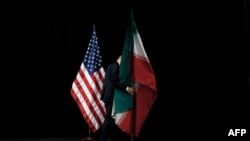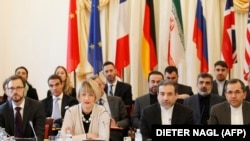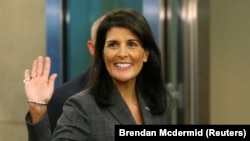The challenge in reading the Iran-US relationship is the daily propaganda in the way. The Supreme Leader rails against a dishonest, plotting America and promises a self-sufficient Resistance Economy that can triumph against any US pressure.
Donald Trump decries the "very bad" July 2015 nuclear deal between the Islamic Republican and the 5+1 Powers. Revolutionary Guards commanders promise defeat for the US Navy in the Persian Gulf. Washington's hawks insist Tehran is covertly breaking the deal and supporting "terrorists" --- even as the US capital's doves are blaming all of Iran's woes on US sanctions.
Reality is far messier, if no less dramatic than the black-and-white portrayals. It is unlikely the Trump Administration, for all its noise, will leave the deal --- Trump has twice certified Iranian compliance with the terms and is reportedly on the verge of doing so again by mid-October.
The Administration is promising pressure on Tehran beyond the accord, yet on two of the region's focal issues --- the Syrian crisis and Iraq amid the fight against the Islamic State --- the US is accepting Iranian influence and has even settled for a de facto convergence of interests, if not co-operation.
Meanwhile the Supreme Leader, if not the Guards and Iranian hardliners, still recognizes that a showdown with Washington is not viable, if only because of Iran's long-crippled economy. So, the Rouhani Government's adherence to the deal, for which it has struggled for years, will continue.
The Administration is promising pressure on Tehran beyond the accord, yet on two of the region's focal issues --- the Syrian crisis and Iraq amid the fight against the Islamic State --- the US is accepting Iranian influence and has even settled for a de facto convergence of interests, if not co-operation.
The denunciation of the US will be accompanied by cordial
The Administration is promising pressure on Tehran beyond the accord, yet on two of the region's focal issues --- the Syrian crisis and Iraq amid the fight against the Islamic State --- the US is accepting Iranian influence and has even settled for a de facto convergence of interests, if not co-operation.
words for European countries, as the Government tries to woo them away from Washington. And while Iran is heavily --- perhaps too heavily --- invested in Syria, Iraq, and groups like Hezbollah and locked in dispute with Saudi Arabia, President Rouhani's self-styled "engagement" will ensure careful maneuvers around the conflicts, if not a reconciliation with past foes.
The Deal and the Region
First, the lodestone of the nuclear deal, the Joint Comprehensive Plan of Action, implemented from January 2016. Trumpian rhetoric fades before the recognition --- not by the President but by others, including Defense Secretary James Mattis, National Security Advisor H.R. McMaster, and State Department officials --- that withdrawal would free Iran to return to the enrichment of 20% uranium, and at a much faster pace than before July 2015. It would likely separate the US not only from China and Russia but also from the three European members of the 5+1 Powers --- Germany, France, and the UK --- and the European Union. The risk of isolation will pass from Tehran to Washington.
The Administration is promising pressure on Tehran beyond the accord, yet on two of the region's focal issues --- the Syrian crisis and Iraq amid the fight against the Islamic State --- the US is accepting Iranian influence and has even settled for a de facto convergence of interests, if not co-operation.
The Supreme Leader may still feel as if he has sipped from the poisoned chalice to have dealt with the US, but having recognized economic priorities in September 2013 when he authorized Rouhani to pursue a final agreement, he is in no stronger a position to risk a break through unilateral departure. The appearance of a renewed drive for "breakout" capability, if not an actual nuclear weapon, would doom the trade and investment quest with European countries.
Russia is too economically weak and too unsettling a partner --- many Iranians view Moscow with almost as much skepticism as the US or the UK --- to provide an alternative. Even China, which has extended a $10 billion loan to Tehran this week, is no outlet: as it proved during the years of sanctions before July 2015, Beijing's political caution and own economic priorities will not make it an economic backer of last resort.
So, the deal stands. But there is a far larger context which is the arena for US-Iranian confrontation.
The sleight-of-hand in the negotiations for the JCPOA was that the agreement was an endpoint, a resolution of more than a decade of tension. But Iran's nuclear program has always been only one chess piece on the board of power, especially in the Middle East. Washington's hawks may have been deceptive in portraying a post-deal financial bonanza unleashing Tehran across the region, but they begin from the starting line: even the longest-term of nuclear agreements offers nothing about the state of play in Syria, Iraq, Yemen, Bahrain, or any other political and sometimes military battleground.
The insistence of the Obama Administration, the EU, and the other 5+1 Powers to keep the nuclear negotiations detached from regional issues was essential for the completion of the JCPOA. But after the deal was confirmed, Washington was caught up in its ongoing uncertainty and indecision in Syria; wavering over how to deal with a troublesome Saudi Arabia which had launched its military intervention in the Yemeni civil war; and caught in Iraq between its distrust of Iranian-led militias and its recognition that they were also fighting ISIS.
Instead the Administration drifted into implementation of the JCPOA --- but maintaining and even extending sanctions on the grounds of Iran's ballistic missile testing --- while looking away from Tehran on the wider issues. On Syria, Washington would deal with Russia, which in turn would work with Iran to prop up the Assad regime. In Iraq, the mantras of the War on ISIS and the support of the Iraqi Government kept distance from Iran's own maneuvers for influence, including with its favored militias.
In Syria, now the focal point of the region's many conflicts, Washington is not even in a position of parity. After years of indecision and then a de facto following of Russia's lead, the US is now largely a bystander in the core of the conflict
In Iran, the line between the nuclear deal and the regional dynamic was drawn in a different and far more decisive way. In June 2014, after ISIS's lightning takeover of much of Iraq, President Rouhani proposed co-operation with Washington. The Supreme Leader bluntly slapped him down: beyond the nuclear negotiations, there would be no public contacts, let alone co-operation, with the Americans.
Tehran pursued its parallel path against ISIS, supporting favored militias and competing with the Americans for influence with Baghdad. In Syria, it sharply escalated its intervention alongside Russia's military entry and Hezbollah's fighters, initially propping up the Assad regime against defeat, then beginning to erode the opposition, and expanding its economic as well as political stake in a partitioned but still important country. And its rivalry with Saudi Arabia spiraled downwards into opposite sides of the Yemeni civil war, as the US --- despite the Obama Administration's fractious relationship with Riyadh --- accepted the Kingdom's aggressive approach to the Gulf, including the support of Bahrain's repression of its dissenters.
Hollow Rhetoric?
The Trump Administration's fist-shaking --- matched on a daily basis by the Supreme Leader's office, judiciary, and the Revolutionary Guards, if not the Rouhani Government --- continues, even as it has again renewed the waiver of widespread sanctions over Iran's nuclear program.
Donald Trump retorted last week. "We are not going to stand for what they're doing to this country. They have violated so many different elements, but they've also violated the spirit of that deal. And you will see what we'll be doing in October. It will be very evident.
It's a deal that should have never, ever been made."
UN Ambassador Nikki Haley, in a high-profile speech in Washington, spoke of a "flawed deal" and of the "big picture", i.e., an American pressure based on Iran's supposed support of "terrorism" and regional activities rather, than an immediate US withdrawal from the JCPOA.
However, the Administration's bite has not necessarily caught up with its bark. Sanctions have been sustained and expanded but largely because of the momentum of Treasury bureaucracy and because of Congress's bill in July, at first opposed by Trump because of provisions also covering Russia.
In Iraq, Washington is locked into an uneasy co-existence with Iran, even as "victory" is declared over ISIS with the recapture of Mosul and the dissolution of the Caliphate. Both countries proclaim support as Baghdad tries to establish a national legitimacy, or at least security forces to hold the line, and both oppose Kurdish independence as the "break-up" of the State and nation. Both look for leverage with the leadership and institutions --- and some of the politicians and groups who are challenging them.
In Syria, now the focal point of the region's many conflicts, Washington is not even in a position of parity. After years of indecision and then a de facto following of Russia's lead, the US is now largely a bystander in the core of the conflict: having led the effort for the Assad regime's nominal control of part of the country, Moscow and Tehran will now try to extract maximum military and political advantage. The one-off US bombing in April of a regime airbase, responding to its sarin attack in northwest Syria, is peripheral. The American position is now one of reliance on a zone in eastern Syria, through support of a Kurdish-led force, which will be off-limits to the Iranians --- and of hope that Israel can establish its buffer area, albeit through talks with Moscow as well as Washington, in the southwest.
The Administration can strike its tough pose through support of Saudi Arabia. Indeed, it already has, through Donald Trump's trip to Riyadh in May and the pledge of $150 billion in arms sales. But even that approach has complications: from political involvement in the deadly Saudi intervention in Yemen to the risk of taking sides in Riyadh's showdown with Gulf neighbor Qatar.
For all the bluster of the Supreme Leader and the Revolutionary Guards, the US conundrum is not primarily because of an Iranian threat over the nuclear deal. In part, it may be of a perceived lack of coherence in a Trump Administration led by an unpredictable President. In larger part, it may be because of post-2003 indecision after failure in Iraq.
But in perhaps the largest and most challenging part, it may be a question of whether the US can still present a "leadership" in the region --- particularly if there are many others, even nominal allies, who no longer see their interests and future as tied to an uncertain American foreign policy.






















